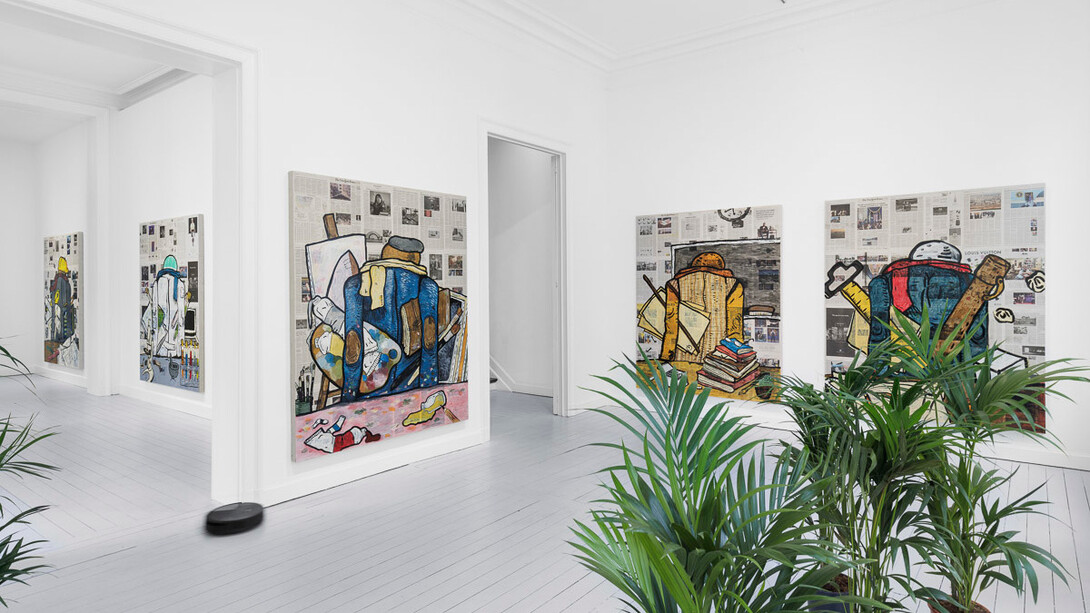For his third solo exhibition at Gladstone, (the intellects take leave), Rirkrit Tiravanija presents seven new paintings on newspapers that reflect on global crises and American political upheaval. Inspired by the practice of the late Canadian-American artist Philip Guston, the new works build upon Tiravanija’s ongoing, multidisciplinary exploration of civil unrest and social issues. (the intellects take leave) is on view in Brussels from November H to December JK, JKJH.
Protest lies at the heart of Rirkrit Tiravanija’s multidisciplinary and participatory art. In JKKL, he inaugurated an ongoing series called demonstration drawings, for which he invited a group of young Thai artists to render graphite facsimiles of photographs from the International herald tribune documenting outbreaks of civil unrest around the world. Images range from violent street protests in Bangkok to Parisians marching in solidarity with Charlie Hebdo to members of Occupy Wall Street demanding economic equity. While public protests have deep historical roots—in the United States they are associated with the civil rights activism of the LSTKs—Tiravanija’s project underscores the continued relevance of protest in today’s political climate. In JKLU, two years into the first Trump presidency, he turned to newspapers again, this time as backdrops for an extraordinary series of paintings in which elements from Philip Guston’s late, figurative canvases were interpreted and transposed onto grids made from sheets of newsprint. Pages from The New York times, covering the election of JKLT and the turmoil wrought by Trump’s anti-immigration policies, created new context for Guston’s own critical response to Nixon’s administration in the LSVKs and the social inequity in the U.S at the time. Tiravanija created a parallel series of paintings layering Gustonian figuration over pages from the Bangkok post, working into and around the current political unrest in his native country.
In these new works, Tiravanija inhabits the extremity of Guston’s figurative vocabulary and explores political unrest in America. Whereas in the initial series, the artist borrowed and remixed the iconic imagery from Guston— shoes, walls, bottles, piles of limbs, burning cigarettes—here, some of the compositions are only evocative of Guston’s troll-ish style. What he does invoke, however, is Guston’s deep lamentation over the state of the world, distraught as he was with the corruption and social injustices of the LSVKs filtered through his own early critiques of fascism and racism as a muralist during the LSWKs. In seven paintings, Tiravanija depicts figures from behind, various archetypes grasping the tools of their trade, as if fleeing their surroundings in a hurry, taking as much as possible of their particular paraphernalia. We see an architect, engineer, scientist, doctor, teacher, judge, and artist in retreat, seeking escape from the assault on independent, progressive thought in the United States under the Trump Administration and its enactment of the ultra-conservative agenda known as Project JKJH. With pages from The New York times announcing Trump’s return to power and his undermining of all democratic norms, Tiravanija creates searing depictions of the country’s brain drain as intellectuals flee an encroaching autocracy and its dire implications for the freedom of expression. In a related work, untitled 2025 (the intellectual takes leave no. one) (new york times, november 22, 2016), Tiravanija has rendered a headless figure in a large overcoat holding piles of rock-like forms, weighed down in a state of hopelessness.
Other paintings on view borrow more directly from Guston’s inventory of abbreviated items—clocks, clouds, shoes, and the like—to invoke, like the series preceding it, despair at the injustices being enacted in the name of governance. As Tiravanija explained in an interview with Hans Ulrich Obrist in Flash art in JKJY: “Guston was one of those artists who always seemed significant for me, particularly regarding the practice. Then Donald Trump comes along with all his hateful and divisive rhetoric. This pointed me towards Guston, who was perhaps misunderstood in some ways… For me, there were elements in Guston’s work that resonated deeply with the situation that we were facing under Donald Trump’s administration, especially considering Guston’s amazing Nixon work. Trump’s actions, such as building the wall and denying entry to people from Arab countries, as well as the movement of lawyers trying to help people cross the border, inspired me to… support the cause.” This new body of work marks a continuation of Tiravanija’s collaboration with the ethos and the ethics of Guston’s most celebrated and controversial paintings. He layers their continued relevance with the relevance of today’s social and political crises, which we are witnessing in real time broadcast across social media platforms and cable television, but most germane here, in the pages of our daily newspapers.












